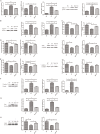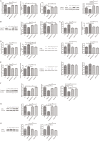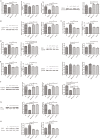Melatonin protects premature ovarian insufficiency induced by tripterygium glycosides: role of SIRT1
- PMID: 28469767
- PMCID: PMC5411910
Melatonin protects premature ovarian insufficiency induced by tripterygium glycosides: role of SIRT1
Abstract
Melatonin confers protective effects on premature ovarian insufficiency (POI) induced by tripterygium glycosides (TG) by reducing oxidative stress. Silent information regulator 1 (SIRT1) signaling is found to be associated with the physiology and pathology of ovary. We hypothesize that melatonin could protect POI via activating SIRT1 signaling. The aim of this study was to investigate the protective effect of melatonin on POI and elucidate its potential mechanisms. Mice were assigned to melatonin treatment with or without SIRT1 inhibitor Ex527 or melatonin receptor antagonist luzindole (Luz) and then subjected to POI. Melatonin conferred a protective effect by improving estrous phase, ovarian and uterus mass and index, increasing ovarian follicles, corpus luteum and anti-mullerian hormone (AMH), decreasing atresia follicles and follicle stimulating hormone (FSH). Melatonin treatment also could reduce malondialdehyde (MDA) level, MDA5, Gp91phox, Caspase3 and Bax expression, and increase total antioxidant activity (TAC), superoxide dismutase (SOD), glutathione peroxidase (GSH-Px) and Bcl-2 expression by up-regulating SIRT1 signaling. However, these protective effects were blocked by Ex527 and Luz, indicating that SIRT1 signaling and melatonin receptor might be specially involved in these effects. In summary, these findings suggest that melatonin protects POI by reducing oxidative stress and apoptotic damage via activation of SIRT1 signaling in a receptor-dependent manner.
Keywords: Premature ovarian insufficiency; SIRT1 signaling pathway; apoptosis; melatonin; melatonin receptor; oxidative stress.
Conflict of interest statement
None.
Figures









Similar articles
-
Melatonin receptor-mediated protection against myocardial ischemia/reperfusion injury: role of SIRT1.J Pineal Res. 2014 Sep;57(2):228-38. doi: 10.1111/jpi.12161. Epub 2014 Aug 13. J Pineal Res. 2014. PMID: 25052362
-
Biochemical changes of oxidative stress in premature ovarian insufficiency induced by tripterygium glycosides.Int J Clin Exp Pathol. 2014 Dec 1;7(12):8855-61. eCollection 2014. Int J Clin Exp Pathol. 2014. PMID: 25674255 Free PMC article.
-
[The Effect and Mechanism of Hyperin on Ovarian Reserve of Tripterygium Glycosides-Induced POI Mice].Sichuan Da Xue Xue Bao Yi Xue Ban. 2021 May;52(3):458-466. doi: 10.12182/20210560103. Sichuan Da Xue Xue Bao Yi Xue Ban. 2021. PMID: 34018365 Free PMC article. Chinese.
-
Therapeutic Effect of Melatonin in Premature Ovarian Insufficiency: Hippo Pathway Is Involved.Oxid Med Cell Longev. 2022 Aug 16;2022:3425877. doi: 10.1155/2022/3425877. eCollection 2022. Oxid Med Cell Longev. 2022. PMID: 36017238 Free PMC article. Review.
-
The Role of Lifestyle and Dietary Factors in the Development of Premature Ovarian Insufficiency.Antioxidants (Basel). 2023 Aug 11;12(8):1601. doi: 10.3390/antiox12081601. Antioxidants (Basel). 2023. PMID: 37627595 Free PMC article. Review.
Cited by
-
Melatonin and Fertoprotective Adjuvants: Prevention against Premature Ovarian Failure during Chemotherapy.Int J Mol Sci. 2017 Jun 7;18(6):1221. doi: 10.3390/ijms18061221. Int J Mol Sci. 2017. PMID: 28590419 Free PMC article. Review.
-
Ginsenoside Rg1 improves pathological damages by activating the p21‑p53‑STK pathway in ovary and Bax‑Bcl2 in the uterus in premature ovarian insufficiency mouse models.Mol Med Rep. 2021 Jan;23(1):37. doi: 10.3892/mmr.2020.11675. Epub 2020 Nov 12. Mol Med Rep. 2021. PMID: 33179093 Free PMC article.
-
Efficacy of Bushen Culuan decoction on ovarian follicle and follicular granulosa cells in mice with premature ovarian insufficiency induced by tripterygium wilfordii polyglycoside.J Tradit Chin Med. 2022 Feb;42(1):23-29. doi: 10.19852/j.cnki.jtcm.2022.01.002. J Tradit Chin Med. 2022. PMID: 35294119 Free PMC article.
-
Comparison of the different animal modeling and therapy methods of premature ovarian failure in animal model.Stem Cell Res Ther. 2023 May 18;14(1):135. doi: 10.1186/s13287-023-03333-4. Stem Cell Res Ther. 2023. PMID: 37202808 Free PMC article. Review.
-
An overview of different methods to establish a murine premature ovarian failure model.Animal Model Exp Med. 2024 Dec;7(6):835-852. doi: 10.1002/ame2.12477. Epub 2024 Sep 1. Animal Model Exp Med. 2024. PMID: 39219374 Free PMC article. Review.
References
-
- Coulam CB, Adamson SC, Annegers JF. Incidence of premature ovarian failure. Obstet Gynecol. 1986;67:604–606. - PubMed
-
- Nelson LM, Covington SN, Rebar RW. An update: spontaneous premature ovarian failure is not an early menopause. Fertil Steril. 2005;83:1327–1332. - PubMed
-
- Gannon AM, Stampfli MR, Foster WG. Cigarette smoke exposure leads to follicle loss via an alternative ovarian cell death pathway in a mouse model. Toxicol Sci. 2012;125:274–284. - PubMed
-
- De Vos M, Devroey P, Fauser BC. Primary ovarian insufficiency. Lancet. 2010;376:911–921. - PubMed
LinkOut - more resources
Full Text Sources
Research Materials
Miscellaneous
